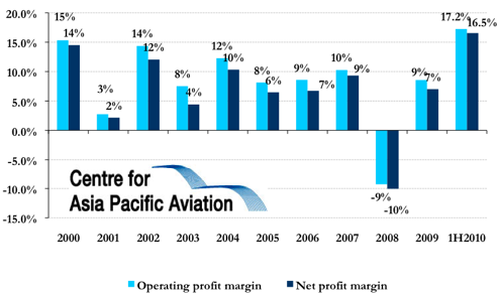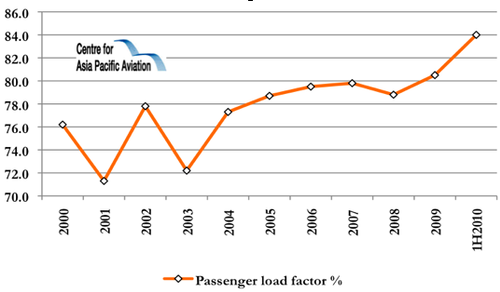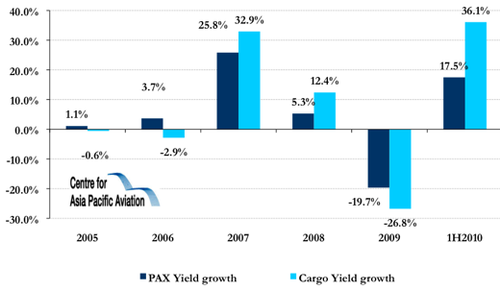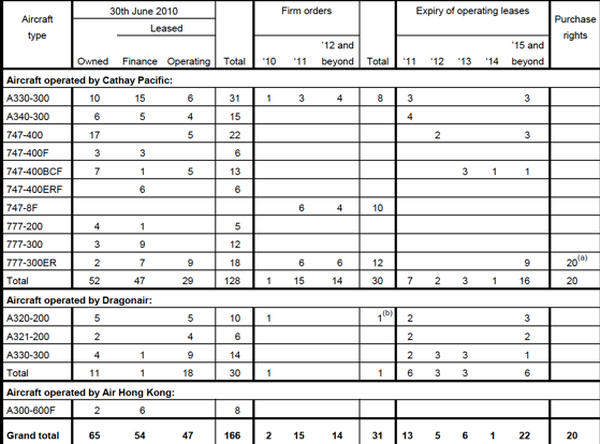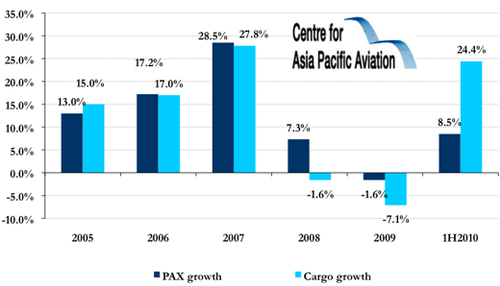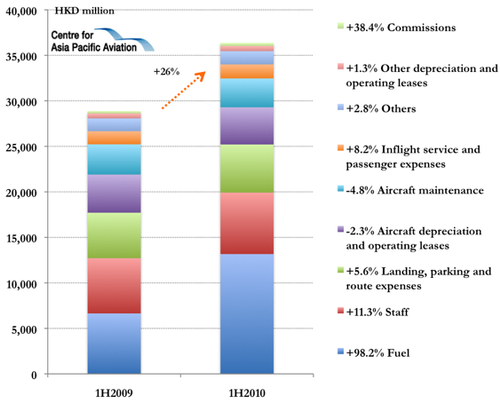Cathay seeing “continuing and significant” recovery; profitability jumps
Cathay Pacific Group stated it experienced a "continuing and significant" recovery in its core business during 1H2010, following what the carrier labeled as extremely challenging conditions in much of the previous year. The carrier added that the turnaround in business that began in 4Q2009 continued into 2010 and gained momentum, with both the passenger and cargo businesses of Cathay Pacific and Dragonair performing well with revenues continuing to increase despite uncertainty over the stability of the global economy.
See related report: Cathay Pacific: No time to get excited, but performing better over long term than Singapore Airlines
Cathay Pacific Group financial/traffic highlights: six months ended 30-Jun-2010 (USD millions)
|
USD |
1H2010 |
% change |
|---|---|---|
|
Revenue (mill) |
5,323 |
+33.7% |
|
Operating costs (mill) |
4,684 |
+26.0% |
|
Fuel |
1,696 |
+98.2% |
|
Labour |
870.4 |
+11.3% |
|
Operating profit (loss) (mill) |
917.7 |
+248.8% |
|
Net profit (loss) (mill) |
880.8 |
+742.2% |
|
Net assets (mill) |
6,294 |
+15.3% |
|
Passenger numbers (mill) |
13.0 |
+8.5% |
|
Passenger load factor |
84.0% |
+5.5 ppts |
|
Passenger yield (USD cents) |
7.52 |
+17.5% |
|
Cargo volume (cargo and mail, tonnes) |
872,000 |
+24.4% |
|
Cargo capacity (ATKs) (mill) |
11,436 |
+3.6% |
|
Cargo load factor |
78.0% |
+11.8 ppts |
|
Cargo yield (USD cents) |
29.10 |
+36.1% |
|
Cost per ATK (cents) |
1.69 |
+22.2% |
|
Cost per ATK (exc fuel) (cents) |
0.26 |
+1.5% |
|
Aircraft utilisation (hours per day) |
11.8 |
+6.3% |
Notable growth in profits; double-digit profit margins in 1H2010
The Cathay Pacific Group reported a USD881 million net profit and a USD918 million operating profit in the six-month period, up 742% and 249%, respectively, as revenues surged 34% to USD5.3 billion.
Cathay Pacific revenue growth and costs growth: 2005 to 1H2010
The carrier reported double-digit operating and net profits margins in the period, of 17.2% and 16.5% respectively.
Cathay Pacific operating profit margin and net profit margin: 2000 to 1H2010
Passenger business experiences "market improvement"; revenues almost returned to pre-crisis levels
Cathay Pacific Chairman, Christopher Pratt, commented that the carrier's passenger business experienced a marked improvement from the lows of 2009, with revenues returning almost to pre-financial crisis levels.
The carrier stated demand for economy class remained "robust". Economy load factors were generally high, as they were during much of the previous year, and economy yields also improved significantly during the period.
Cathay Pacific and Dragonair capacity, load factors and yields by region: 1H2010
|
Capacity (mill) |
% change |
Load Factor |
% change |
Yield |
|
|---|---|---|---|---|---|
|
Passenger services |
|||||
|
India, Middle East, Pakistan and Sri Lanka |
5,475 |
+7.2% |
78.3% |
+4.2 ppts |
+5.7% |
|
6,811 |
-2.0% |
82.4% |
+5.8 ppts |
+13.4% |
|
|
9,173 |
+0.2% |
80.6% |
+1.5 ppts |
+25.4% |
|
|
9,838 |
-5.9% |
85.8% |
+2.7 ppts |
+20.5% |
|
|
11,548 |
+0.8% |
80.3% |
+12.3 ppts |
+10.2% |
|
|
12,835 |
+1.6% |
91.7% |
+5.1 ppts |
+20.6% |
|
|
Overall |
55,680 |
-0.1% |
84.0% |
+5.5 ppts |
+17.5% |
|
Cargo services |
6,135 |
+7.1% |
78.0% |
+11.8 ppts |
+36.1% |
"Sharp" increase in business travel demand ex Hong Kong; premium revenue remain below pre-crisis levels
In the premium classes there was a "sharp" increase in demand for business travel originating in Hong Kong, although the carrier stated it was not matched by a comparable increase in demand for travel originating in other major cities.
The carrier added that there was a corresponding rise in corporate sales, particularly in the key Hong Kong market, during the period, with yields improving significantly, though premium class traffic and revenue were both still below pre-downturn levels.
13 million pax in 1H2010; double-digit yield and revenue increases
Cathay and Dragonair handled 13.0 million passengers in the six month period, an 8.5% year-on-year increase despite a 0.1% capacity (ASKs) reduction, with a 5.5 ppt load factor improvement.
Cathay Pacific PLF: 2000 to 1H2010
Cathay Pacific Airways commentary by region
|
Region |
Passenger services |
|---|---|
|
Mainland China |
Business to/from Mainland China saw healthy growth, particularly to secondary cities. The 2010 Shanghai Expo helped to generate more traffic to Mainland China's major commercial city, with the carrier adding that there was a general increase in the number of people travelling from overseas to major commercial cities in Mainland China. Business to/from the Pearl River Delta continued to grow, assisted by the Dragonair service to Guangzhou which was launched in Sep-2009 year. Capacity on the route was increased over the Canton Fair period. However, services to four Dragonair destinations in Mainland China - Dalian, Guilin, Shenyang and Xian - remain suspended. |
|
Business on Taiwan services, particularly traffic from Taiwan to the Mainland, continued to be affected by cross-Strait direct flights, with the carrier conceding that an increase in the number of direct flights from 270 to 370 per week progressively from Jun-2010 will have a further impact. Despite this, Cathay added two daily services to Taipei - one in June and another in July - and also added four Dragonair flights per week to Kaohsiung in Jul-2010. However, Dragonair has yet to resume services to Taichung in Taiwan. |
|
|
Cathay stated Japan routes were "strong" for travel in both directions. The carrier plans to launch twice-daily service to Tokyo Haneda Airport from Oct-2010, while Dragonair will resume daily services to Fukuoka in Oct-2010. |
|
|
Cathay stated it saw growth on Korean routes during the quarter with business showing a gradual pick-up in both directions. |
|
|
Cathay stated Southeast Asian destinations performed well in general during the quarter, though business on the Bangkok route was affected by continued political unrest in the country. The Philippines and Indonesian routes performed well, though traffic on the Denpasar route was affected by the introduction of more direct services from Europe. |
|
|
Premium class travel to Australia and New Zealand is "still not back to previous levels", according to Cathay. However, business to secondary cities in Australia (such as Brisbane and Perth) was "above expectations", with the carrier commenting: "We will look for opportunities to increase capacity on these routes". |
|
|
Cathay stated the Delhi and Mumbai routes were affected by strong competition from Indian carriers, though business on the Chennai and Bengaluru routes has been steadily improving. Dragonair resumed a daily service to Bengaluru in Mar-2010. |
|
|
Demand on the Saudi Arabia routes has been strong, with the carrier now operating daily service on the Jeddah route, which was launched in Oct-2009. |
|
|
Business traffic from Mainland China and Japan helped to improve the carrier's performance on the South African route. The World Cup was another positive factor in the period, with the carrier increasing capacity in Jun-2010 in response to increased demand during the period of the competition. |
|
|
Cathay stated the Toronto route experienced the strongest recovery in premium class travel. All other routes experienced continued high load factors in economy class. |
|
|
Demand on the London route was strong with premium business traffic recovering more quickly than on other routes, according to the carrier. Demand on other European routes was affected by an "increase in competition and a relatively slow recovery in business travel". Cathay Pacific Group launched two new Europe routes during the period, with services to Milan and Moscow. The carrier added that load factors on the Milan route have been "encouraging". |
Cathay's passenger revenue for the period increased 25.7% to USD3.5 billion, with a yield increase of 17.5% to USD 7.52 cents.
Cathay Pacific pax yield growth and cargo yield growth: 2005 to 1H2010
Capacity almost restored to pre-crisis levels
Capacity, which was reduced in 2009 in response to the economic downturn, was gradually restored by both Cathay Pacific and Dragonair in the half, with the carrier stating that at the end of Jun-2010, capacity, "capacity had almost been restored to pre-downturn levels".
Planning to purchase 36 new widebodies
During the six-month period, Cathay's fleet was strengthened by the addition of four new B777-300ERs. The carrier added that of the six passenger aircraft parked in the desert, the four A340-300s will be returned under terms of their operating leases in 2011, leaving two B747-400s grounded.
Cathay Pacific fleet profit: as at 30-Jun-2010
Big new widebody order - no A380s (yet)
However, the most interesting fleet news was the announcement by Cathay Pacific of its intention to purchase 36 new aircraft, valued at approximately HKD75 billion (USD9.7 billion), as follows:
- Airbus: Entered into a LoI for the acquisition of 30 Rolls-Royce (Trent XWB) powered A350-900 aircraft, for delivery between 2016 and 2019, with the carrier stating: "The all-new A350XWB will form the backbone of Cathay Pacific's future mid-size widebody fleet." Mr Tyler added: "The [A350] delivery schedule fits our requirements very neatly. The 30 new aircraft will be deployed to replace older aircraft and grow our fleet to meet the challenges of the future" and commented that the purchasing process had been a "rigorous and competitive one that has produced the best result for Cathay Pacific at the end of the day". Airbus would have been hoping to sell its flagship A380s to Cathay - a move that is not entirely out of the question even with the A350 deal;
- Boeing: Expressed its intention to exercise existing purchase rights in respect of six General Electric powered B777-300ER aircraft (in addition to the 30 aircraft of this type already on firm order), with the carrier adding that the order is "subject to the satisfactory outcome of negotiations with the Boeing Company". The total value of the intended aircraft purchases at list price is approximately HKD75 billion. Eighteen 777-300ERs have already been delivered and are in operation with the remaining 12 arriving by 2013. The carrier added that B777-300ER equipment will be the "backbone of its ultra-long-haul and long-haul fleet, chiefly serving destinations in North America and Europe".
Freight remains strong in 1H2010 despite continued economic uncertainty
Mr Pratt described the carrier's cargo business as "very robust" through 1H2010, with strong demand in all key markets. The cargo load factor increased by 11.8 ppts year-on-year, reaching a record of 78.0%. As a result of the stronger demand, the carrier stated that, by Jul-2010, it had brought back into service all five aircraft parked in the desert during the 2009 downturn.
In 1H2010, freight volumes handled by both airlines increased by 24.4% to 872,000 tonnes, with cargo revenue increasing 63.1% USD1.5 billion, while yields soared 36.1% (off a very weak base) to USD 29.10 cents. This strong growth occurred despite continued economic uncertainty, particularly in a number of Eurozone economies.
Cathay Pacific Pax growth and cargo volume growth: 2005 to 1H2010
Rising fuel costs a concern
During the first half, Cathay reported a 26% increase in operating costs, to USD4.7 billion, as part of which fuel costs increased 98% to represent 36% of the total. The carrier expressed concerns about the potential rise in fuel costs.
Cathay Pacific cost breakdown: 1H2009 to 1H2010
Proceeds with Air China cargo JV; air cargo terminal in Hong Kong and disinvestments in HACTL and HAECO
The carrier's also announced details of a few key developments in the period, as follows"
Cathay Pacific Airways key developments: 1H2010
|
Area |
Details |
|---|---|
|
New cargo JV with Air China |
Cathay's strategic partnership with Air China continues to go "from strength to strength", according to the carrier. In Feb-2010, the carrier announced the formation of a new cargo joint venture based in Shanghai. The two airlines will use an existing Air China subsidiary, Air China Cargo (in which Cathay will take equity and economic interest of 49%), as the platform for the JV, which is expected to begin operations in Oct-2010. As part of the arrangements, Cathay will sell four B747-400BCF freighters two spare engines to Air China Cargo, with one of the aircraft being transferred later this year. The joint venture will enable Cathay to exploit air cargo opportunities in the important Yangtze River Delta region, although the carrier confirmed that it remains committed to its Hong Kong hub. |
|
Construction of cargo terminal in Hong Kong |
Cathay recommenced work in Mar-2010 on its own cargo terminal at Hong Kong International Airport which will be a HKD5.5 facility designed to enhance the competitiveness and efficiency of Hong Kong as an airfreight hub. |
|
A requirement of the agreement with the Hong Kong Airport Authority in relation to the new cargo terminal was the disposal of its 10% shareholding in Hong Kong Air Cargo Terminals Limited (HACTL). This was completed in May-2010 realising cash of HKD640 million and a profit of HKD328 million. In Jun-2010, Cathay also sold its remaining 15% interest in Hong Kong Aircraft Engineering Company Limited (HAECO), realising cash of HKD2,620 million and a profit of HKD1,837 million. This disposal, at a 25% premium to the latest market price of HAECO shares immediately before the public announcement of the transaction, was consistent with the carrier's strategy of focusing on our core operations and has freed up cash for forthcoming investments |
Improved outlook but uncertainty remains
The outlook for Cathay Pacific Group is now much improved, after a very challenging 2009. In 2010, Cathay has "been able to get our business back on track", with capacity being restored, an improvement in its financial situation and a strengthening of the carrier's balance sheet.
Mr Pratt commented that, on present trends, the carrier expects continued strength in its financial results in 2H2010, although he cautioned that conditions can change rapidly in the airline industry. A key concern centres on a potential further increase in fuel prices or any return to the recessionary economic conditions of 2008 and much of 2009.
However, in the long-term, he stated the carrier remains confident of its long-term future, adding that it has a "number of things working in our favour, including our capable, supportive and committed team, a superb international network, effective management of costs, our quality service and product offering, a strong relationship with Air China, and our position in Hong Kong - one of the world's great cities and a premier international aviation hub. These core strengths will, I believe, ensure the continued success of the Company".

